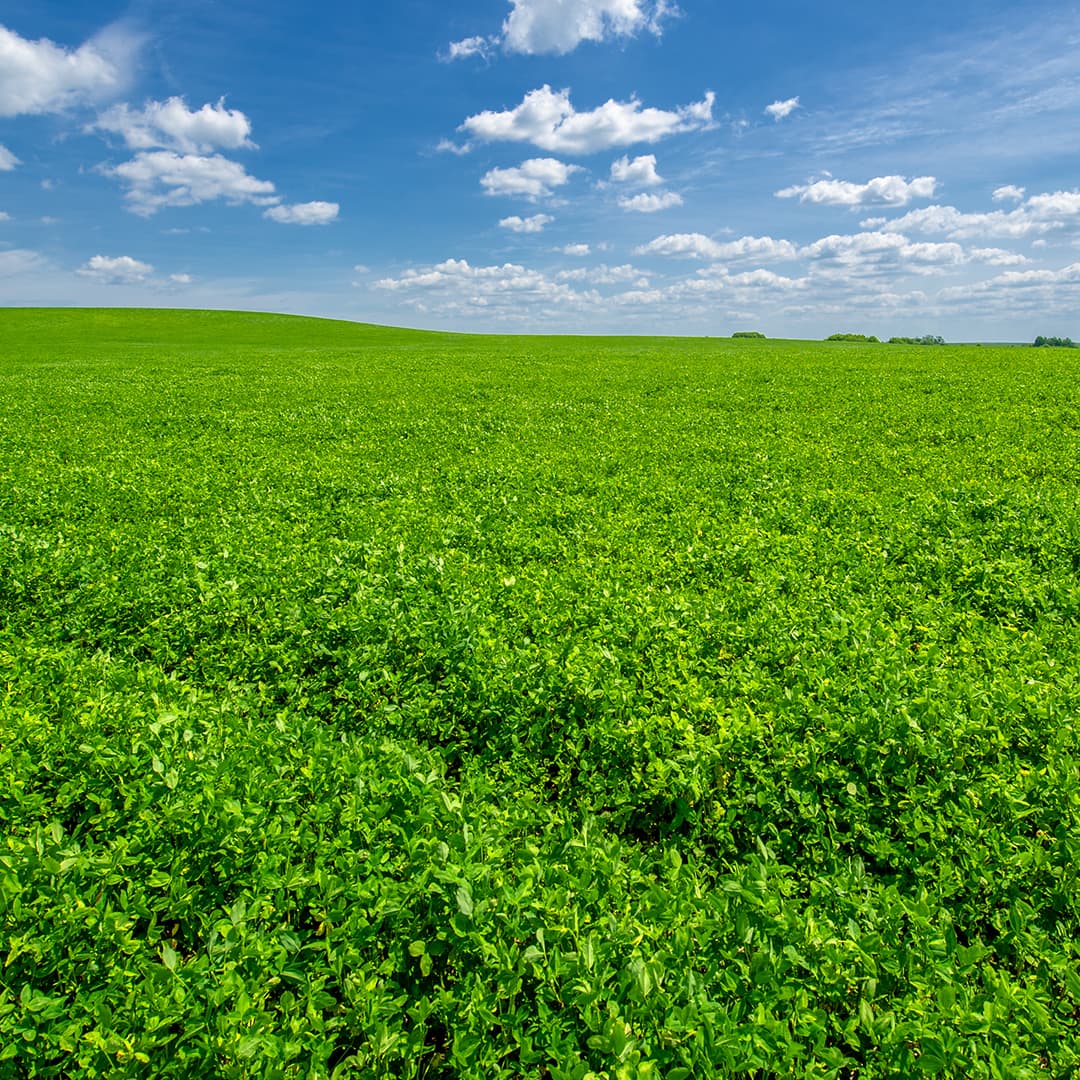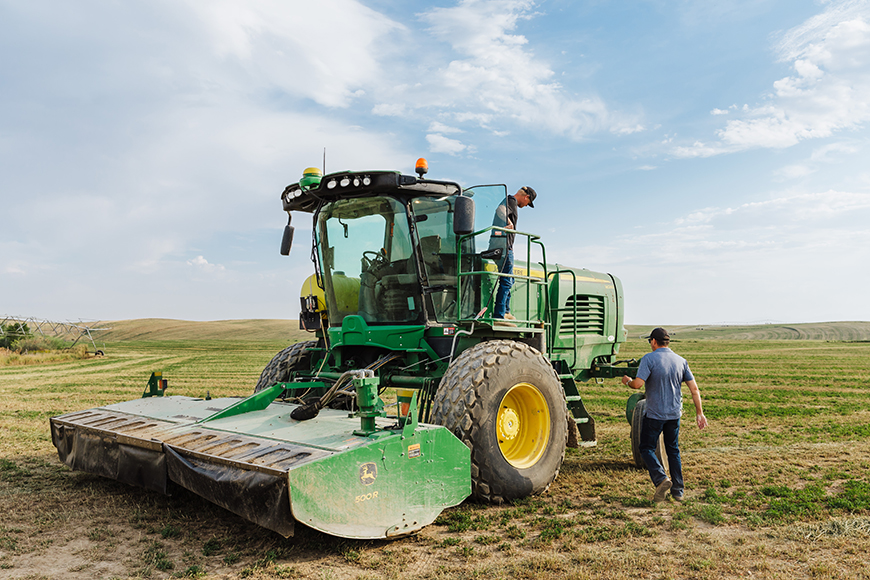Relative Forage Quality: A New Way to Measure Alfalfa Nutritive Value
Over the years, scientists have developed a number of laboratory analyses aimed at quickly and inexpensively estimating the nutritive value of alfalfa. Probably the most widely accepted analysis used to rank and characterize alfalfa in the U.S. is Relative Feed Value (RFV). RFV is a numeric value assigned to forages based upon their ADF (acid detergent fiber) and NDF (neutral detergent fiber) values. In the RFV calculation, NDF is used to estimate the dry matter intake expected for given forage and the ADF concentration is used to estimate the digestibility of the forage. By combining these two relationships, an estimate of digestible dry matter intake is generated. This value is then reported relative to a standard forage (full bloom alfalfa=100) and can be used to rank forages based on their anticipated feeding value. RFV has been widely accepted as a means of estimating forage-feeding value, and RFV is often used to determine the price of alfalfa at tested hay auctions.
Several years ago, the National Research Council (NRC) issued revised feeding guidelines in their report “NRC Nutrient Requirements for Dairy Cattle.” Scientists at the University of Wisconsin, the University of Florida, and the USDA Dairy Forage Research Lab viewed these new guidelines as an opportunity to improve upon the RFV index through the incorporation of newer analyses and equations that have come available in recent years.
Relative Forage Quality (RFQ) has been proposed as a new term to replace RFV when estimating the nutritive value of alfalfa. How do RFV and RFQ differ? Basically, the ADF (or dry matter intake) term used for the RFV calculation will be replaced by a TDN (Total Digestible Nutrients) term derived from the new NRC recommendations using in vitro estimates of digestible NDF. In general, one would expect the digestibility estimates used for RFQ calculation (digestible NDF from in vitro assay) to more accurately characterize the feeding value of a forage than the digestibility estimate used for RFV calculation (laboratory ADF measurement).
W-L Research has long been a proponent of replacing the ADF measurements of digestibility with in vitro digestibility measurements. In our experience, digestible NDF accurately predicts the digestibility of forage when fed. Therefore, we feel that use of the new, proposed RFQ index will provide a significant improvement in our efforts to more accurately rank and characterize the feeding value of different alfalfas.
However, we will continue to measure and report true digestibility measures (e.g. in vitro true digestibility or IVTD) at W-L Research. These measures of digestibility utilize actual rumen microorganisms, and provide a very accurate assessment of a forages feeding value. We have been digesting alfalfa samples in rumen liquor collected from fistulated cows for over ten years and have found that %IVTD information provides valuable insight into the true feeding value of forage.
Where do we go from here? The RFV index is widely used and well understood by many growers, hay producers, and nutritionists throughout the U.S. It will take a concerted effort by University and USDA researchers, as well as private nutritionists and industry specialists, to spread the good word about the new RFQ forage quality index. At W-L Research, we plan to move to the new RFQ index as quickly as possible and we will also continue to provide true digestibility (e.g. %IVTD) information so our customers can more accurately balance rations for their high-producing dairy and beef cows.
Over the years, scientists have developed a number of laboratory analyses aimed at quickly and inexpensively estimating the nutritive value of alfalfa. Probably the most widely accepted analysis used to rank and characterize alfalfa in the U.S. is Relative Feed Value (RFV). RFV is a numeric value assigned to forages based upon their ADF (acid detergent fiber) and NDF (neutral detergent fiber) values. In the RFV calculation, NDF is used to estimate the dry matter intake expected for given forage and the ADF concentration is used to estimate the digestibility of the forage. By combining these two relationships, an estimate of digestible dry matter intake is generated. This value is then reported relative to a standard forage (full bloom alfalfa=100) and can be used to rank forages based on their anticipated feeding value. RFV has been widely accepted as a means of estimating forage-feeding value, and RFV is often used to determine the price of alfalfa at tested hay auctions.
Several years ago, the National Research Council (NRC) issued revised feeding guidelines in their report “NRC Nutrient Requirements for Dairy Cattle.” Scientists at the University of Wisconsin, the University of Florida, and the USDA Dairy Forage Research Lab viewed these new guidelines as an opportunity to improve upon the RFV index through the incorporation of newer analyses and equations that have come available in recent years.
Relative Forage Quality (RFQ) has been proposed as a new term to replace RFV when estimating the nutritive value of alfalfa. How do RFV and RFQ differ? Basically, the ADF (or dry matter intake) term used for the RFV calculation will be replaced by a TDN (Total Digestible Nutrients) term derived from the new NRC recommendations using in vitro estimates of digestible NDF. In general, one would expect the digestibility estimates used for RFQ calculation (digestible NDF from in vitro assay) to more accurately characterize the feeding value of a forage than the digestibility estimate used for RFV calculation (laboratory ADF measurement).
W-L Research has long been a proponent of replacing the ADF measurements of digestibility with in vitro digestibility measurements. In our experience, digestible NDF accurately predicts the digestibility of forage when fed. Therefore, we feel that use of the new, proposed RFQ index will provide a significant improvement in our efforts to more accurately rank and characterize the feeding value of different alfalfas.
However, we will continue to measure and report true digestibility measures (e.g. in vitro true digestibility or IVTD) at W-L Research. These measures of digestibility utilize actual rumen microorganisms, and provide a very accurate assessment of a forages feeding value. We have been digesting alfalfa samples in rumen liquor collected from fistulated cows for over ten years and have found that %IVTD information provides valuable insight into the true feeding value of forage.
Where do we go from here? The RFV index is widely used and well understood by many growers, hay producers, and nutritionists throughout the U.S. It will take a concerted effort by University and USDA researchers, as well as private nutritionists and industry specialists, to spread the good word about the new RFQ forage quality index. At W-L Research, we plan to move to the new RFQ index as quickly as possible and we will also continue to provide true digestibility (e.g. %IVTD) information so our customers can more accurately balance rations for their high-producing dairy and beef cows.



